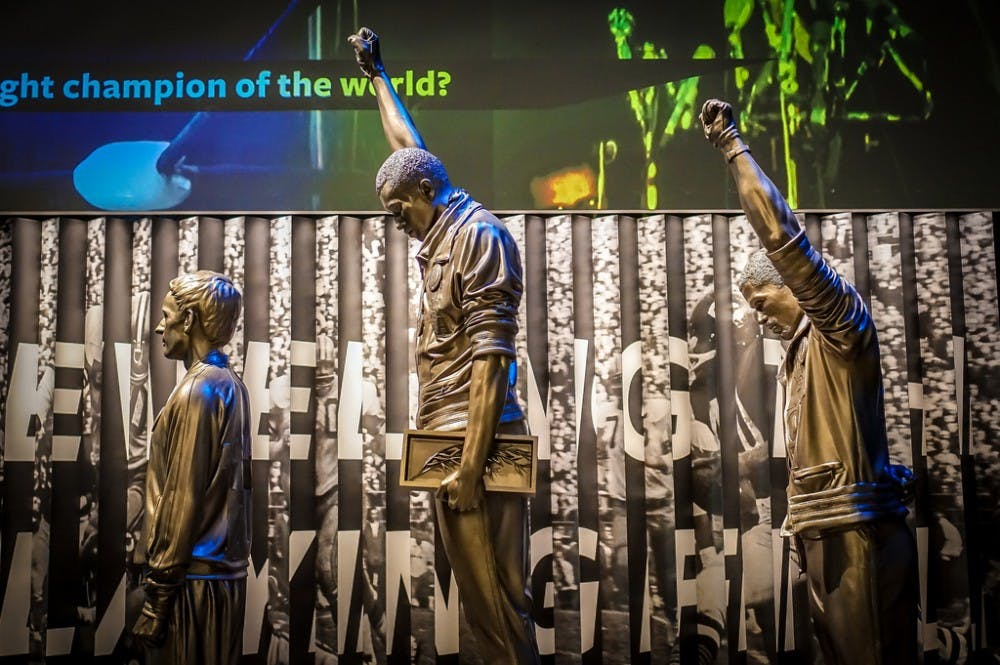Freshman residents of Fisher Hassenfeld and Hill College Houses saw 616 years of African American experiences in just four hours, during a trip to the Smithsonian National Museum of African American History and Culture.
In September, the Smithsonian National Museum of African American History and Culture commemorated its first anniversary. As part of the celebration, the Museum held two “Community Days” with special programs highlighting local black talent. Sponsored by Makuu, a group of Penn freshmen traveled to Washington, DC, to take part in the festivities.
The museum has five floors. The first three separate African American history into different eras with stunning attention to detail, the fourth houses interactive exhibits, and the fifth is dedicated to modes of cultural expression relevant to the African American identity. It is on this floor that one finds the exhibits "Visual Art and the American Experience", "Taking the Stage", and "Musical Crossroads," which display artwork, motion picture relics, and musical accomplishments by African American artists.
The four hours students spent at the museum was not enough time to browse all the information it offered. Michelle Gilliard Houston, associate director of Makuu, explained the importance of the day trip.
“I think that a visit to the African American Museum for people of African descent is necessary to affirm all of our contributions to this country. It’s something that people should try to make their pilgrimage," Houston said
In a country where the needs and contributions of African Americans are often overlooked, artistic outlets of expression are necessary for many reasons: 1) to educate and inform others of Black culture, 2) to celebrate and recognize African American contributions in a society that generally fails to do so, and 3) to inspire and guide future generations of Black Americans.
With artwork that focused on the theme of “blackness,” the "Visual Art and the American Experience" exhibit touches on all three of these reasons. Upon first glance, the exhibit is reminiscent of other art galleries. The colors are eye catching, and almost every art style is represented. But a look at the information plaques adds even greater meaning to both the artwork and the exhibit as a whole; bright colors now represent the joys of an entire people, and the many styles demonstrate the versatility of black artists on an amazing scale. “A lot of the pure artistry in paintings reflects our cultural roots in Africa, and seeing how that work has been molded over centuries in America is particularly poignant because you can see the growth and evolution of African American artistry,” Noni Unobagha (C ‘21) said.
Historically, when African Americans were silenced by slavery and discrimination, music and art were the only ways to make black voices heard. Curators at the African American Museum amplify those voices in a way that resonates with all who visit. Ashley Anumba (C ‘21) notes, “It is a different experience, being in a museum about black culture with people who understand my struggle instead of being in a classroom with people who may not understand me.”
When asked if the museum gave a large enough platform to African American artforms, Ashley, Noni, and Houston said that curators have taken a step in the right direction. “The museum does the job of highlighting, preserving, and affirming the African American experience, which gives us all a sense of pride,” said Houston.
The museum truly is a must–see, not just for those of the African diaspora, but also for anyone who wishes to learn more about the African American experience. In fact, Penn students were met with crowds of visitors of every race and ethnicity, all united in observance of yet another milestone for the black community.
The Smithsonian National Museum of African American History and Culture has free admission, but timed passes are required for entry. If you can’t make the trip to Washington, DC, try visiting The African American Museum in Philadelphia. Admission for adults is $14.







